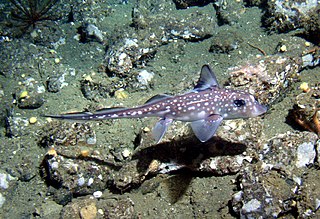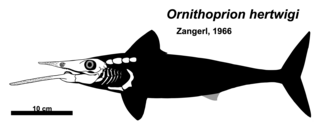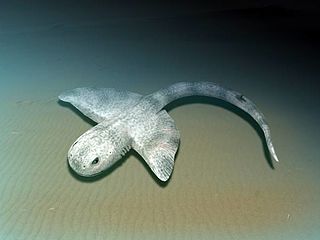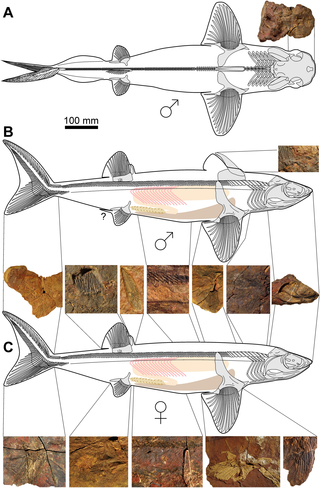
Chondrichthyes is a class of jawed fish that contains the cartilaginous fish or chondrichthyans, which all have skeletons primarily composed of cartilage. They can be contrasted with the Osteichthyes or bony fish, which have skeletons primarily composed of bone tissue. Chondrichthyes are aquatic vertebrates with paired fins, paired nares, placoid scales, conus arteriosus in the heart, and a lack of opercula and swim bladders. Within the infraphylum Gnathostomata, cartilaginous fishes are distinct from all other jawed vertebrates.

Chimaeras are cartilaginous fish in the order Chimaeriformes, known informally as ghost sharks, rat fish, spookfish, or rabbit fish; the last three names are not to be confused with rattails, Opisthoproctidae, or Siganidae, respectively.

Acanthodii or acanthodians is an extinct class of gnathostomes. They are currently considered to represent a paraphyletic grade of various fish lineages basal to extant Chondrichthyes, which includes living sharks, rays, and chimaeras. Acanthodians possess a mosaic of features shared with both osteichthyans and chondrichthyans. In general body shape, they were similar to modern sharks, but their epidermis was covered with tiny rhomboid platelets like the scales of holosteians.

Cladoselache is an extinct genus of shark-like chondrichthyan from the Late Devonian (Famennian) of North America. It was similar in body shape to modern lamnid sharks, but was not closely related to lamnids or to any other modern (selachian) shark. As an early chondrichthyan, it had yet to evolve traits of modern sharks such as accelerated tooth replacement, a loose jaw suspension, enameloid teeth, and possibly claspers.

Helicoprion is an extinct genus of shark-like eugeneodont fish. Almost all fossil specimens are of spirally arranged clusters of the individuals' teeth, called "tooth whorls", which in life were embedded in the lower jaw. As with most extinct cartilaginous fish, the skeleton is mostly unknown. Fossils of Helicoprion are known from a 20 million year timespan during the Permian period from the Artinskian stage of the Cisuralian to the Roadian stage of the Guadalupian. The closest living relatives of Helicoprion are the chimaeras, though their relationship is very distant. The unusual tooth arrangement is thought to have been an adaption for feeding on soft bodied prey, and may have functioned as a deshelling mechanism for hard bodied cephalopods such as nautiloids and ammonoids. In 2013, systematic revision of Helicoprion via morphometric analysis of the tooth whorls found only H. davisii, H. bessonowi and H. ergassaminon to be valid, with some of the larger tooth whorls being outliers.

Stethacanthus is an extinct genus of shark-like cartilaginous fish which lived from the Late Devonian to Late Carboniferous epoch, dying out around 298.9 million years ago. Fossils have been found in Australia, Asia, Europe and North America.

Cobelodus is an extinct genus of cartilaginous fish known from the late Carboniferous to the early Permian period. The type specimen, assigned to the genus Styptobasis, was discovered by Edward Drinker Cope in Illinois Basin black coal shales. Rainer Zangerl reassigned S. aculeata in 1973 to the genus Cobelodus, translating to 'needle tooth'. Cope's description was based from a tooth fragment and was compared to the genus Monocladodus. Cobelodus differs from Styptobasis and Monocladodus in the anatomy of its teeth and pectoral fins.

Stethacanthidae is an extinct family of prehistoric holocephalians. It is estimated to have existed approximately between 380 and 300 million years ago. Members of this family are noted for their peculiar dorsal fin.

Symmorium is an extinct symmoriiform cartilaginous fish from the Devonian and Carboniferous of the United States (Illinois) and Russia. The type species, Symmorium reniforme, was named by Edward Drinker Cope in 1893, with other species assigned to the genus having since been reclassified into other genera such as Petalodus. Symmorium bears close similarity in size and appearance to Stethacanthus but lacks the "spine-brush complex" in place of the first dorsal fin. Some paleontologists think that the two forms represented the males and females of related species, while other scientists think they were distinct genera.

Hybodontiformes, commonly called hybodonts, are an extinct group of shark-like cartilaginous fish (chondrichthyans) which existed from the late Devonian to the Late Cretaceous. Hybodonts share a close common ancestry with modern sharks and rays (Neoselachii) as part of the clade Euselachii. They are distinguished from other chondrichthyans by their distinctive fin spines and cephalic spines present on the heads of males. An ecologically diverse group, they were abundant in marine and freshwater environments during the late Paleozoic and early Mesozoic, but were rare in open marine environments by the end of the Jurassic, having been largely replaced by modern sharks, though they were still common in freshwater and marginal marine habitats. They survived until the end of the Cretaceous, before going extinct.

The Eugeneodontida, sometimes also called Eugeneodontiformes, is an extinct and poorly known order of cartilaginous fishes. They possessed "tooth-whorls" on the symphysis of either the lower or both jaws and pectoral fins supported by long radials. They probably lacked pelvic fins and anal fins. The palatoquadrate was either fused to the skull or reduced. Now determined to be within the Holocephali, their closest living relatives are chimaeras. The eugeneodonts are named after paleontologist Eugene S. Richardson, Jr. The group first appeared in the fossil record during the late Mississippian (Serpukhovian). The youngest eugeneodonts are known from the Early Triassic. The geologically youngest fossils of the group are known from the Sulphur Mountain Formation, Vardebukta Formation and Wordie Creek Formation (Greenland).

Iniopterygiformes is an extinct order of chimaera-like cartilaginous fish that lived from the Devonian to Carboniferous periods. Fossils of them have been found in Montana, Indiana, Illinois, and Nebraska. The Iniopterygians are characterized by large pectoral fins, wing-like projections on their backs, mounted high on the body and denticulated bony plates on the head and jaws. Iniopterygian sharks were small, and their average length was about 18 inches (46 cm). The elongated pectoral fins had denticles along the leading edge which may have had a role in mating. They are thought to have been able to move their pectorals in a vertical plane, ”flying” through the water much like modern-day flying fish.

The Fayetteville Shale is a geologic formation of Mississippian age composed of tight shale within the Arkoma Basin of Arkansas and Oklahoma. It is named for the city of Fayetteville, Arkansas, and requires hydraulic fracturing to release the natural gas contained within.

Cladodus is an extinct genus of cartilaginous fishes in the family Ctenacanthidae. As the name implies, they are a type of cladodont, primitive sharks with teeth designed to snag fish and swallow them whole, instead of sawing off chunks to swallow.

Ornithoprion is a monotypic genus of extinct eugeneodont chondrichthyan in the family Caseodontidae. The type and only species, O. hertwigi, lived during the Moscovian stage of the Pennsylvanian, between 315.2 to 307 million years ago, and is known from black shale deposits in what is now the Midwestern United States. The discovery and description of Ornithoprion, performed primarily via radiography, helped clarify the anatomy of the eugeneodonts, a group which were previously known primarily from isolated tooth whorls. The genus derives its name from its pointed, bill-like armored skull and large eyes, which vaguely resemble the features of a bird, while the species name honors Oscar Hertwig. It is known from specimens preserving the skull and anterior portion of the body.

Antarctilamna is an extinct genus of Devonian cartilaginous fish originally exemplified by Antarctilamna prisca from South Eastern Australia and Antarctica. The latest occurring described species is Antarctilamna ultima from the Waterloo Farm lagerstätte in South Africa. Antarctilamna has robust ctenacanthid-like spines which lack a deep insertion area, and are borne in front of the first dorsal fin; in addition to distinctive diplodont teeth with small intermediate cusps. Antarctilamna-like spines, known from the Bunga Beds locality in Australia have been ascribed to A. prisca.
Ozarcus is an extinct genus of symmoriiform cartilaginous fish from the Carboniferous period of Arkansas. The type species, Ozarcus mapesae, was named in 2014 based on cartilaginous skulls from the Serpukhovian-age Fayetteville Formation. The genus is named after the Ozark Mountains while the species was named after its discoverer, G. K. Mapes.

Romerodus is an extinct genus of cartilaginous fish in the family Caseodontidae. While it and the rest of its family were historically considered elasmobranchs related to sharks and rays, they are now regarded as holocephalans, a diverse subclass which is today only represented by chimaeras. Romerodus is known from the Carboniferous and possibly Permian periods of North America, and the type and only named species, R. orodontus, was discovered in organic shale deposits in the U.S. state of Nebraska. It is one of few members of its order, the Eugeneodontida, which is known from multiple complete, well preserved body fossils, and is thus an important taxon for understanding the anatomy and ecology of less well preserved eugeneodonts such as Helicoprion. Unlike its larger relatives, Romerodus grew to approximately 50 cm in total length.

Squatinactis is a genus of extinct elasmobranch chondrichthyan known from the Carboniferous aged Bear Gulch Limestone in Montana. This fish was discovered in 1974 by Richard Lund. The type specimen, named CMNH 46133, consists of a brain case, poorly preserved jaws and gills, a pectoral fin, and a partial vertebral axis. This creatures most startling feature were its broad pectoral fins which resembled those of stingrays and angel sharks (Squatina). The holotype specimen has about 15 teeth in its jaw. This creature is named after the angel shark. Remains found in the South Urals of Russia and the Eyam Limestone of Derbyshire, England, have been tentatively identified as those belonging to S. caudispinatus.

Maghriboselache is an extinct genus of cladoselachid symmoriiform fish that lived 369 million years ago during the Late Devonian of Morocco. The genus contains a single species, M. mohmezanei. Maghriboselache represents the first cladoselachid to be discovered with significant details of the jaws, braincase and even endocranium. Along with Cladoselache, it shares a unique and distinctive tooth and upper jaw morphology.
























